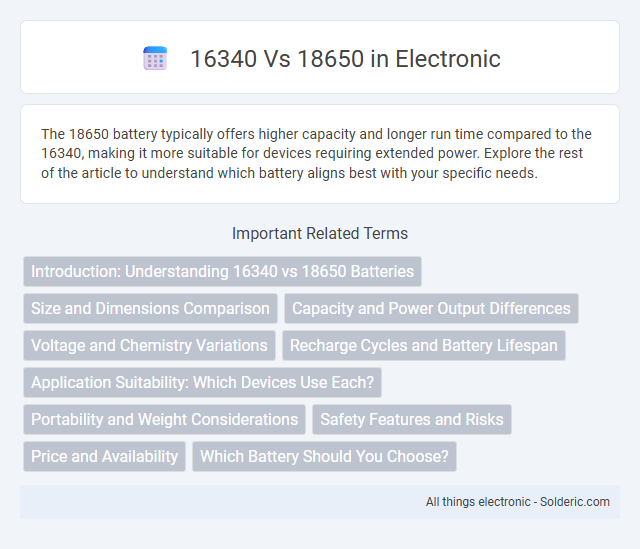The 18650 battery typically offers higher capacity and longer run time compared to the 16340, making it more suitable for devices requiring extended power. Explore the rest of the article to understand which battery aligns best with your specific needs.
Comparison Table
| Feature | 16340 Battery | 18650 Battery |
|---|---|---|
| Dimensions | 16mm diameter x 34mm length | 18mm diameter x 65mm length |
| Capacity | 600-1200mAh | 1800-3500mAh |
| Voltage | 3.6-3.7V | 3.6-3.7V |
| Rechargeable | Yes (Li-ion or LiFePO4) | Yes (Li-ion or LiFePO4) |
| Typical Use | Compact devices, flashlights, vape mods | High-drain devices, laptops, power banks |
| Weight | Approx. 20-30g | Approx. 40-50g |
| Recharge Cycles | 300-500 cycles | 300-500 cycles |
Introduction: Understanding 16340 vs 18650 Batteries
16340 and 18650 batteries are both lithium-ion rechargeable cells commonly used in portable electronics and high-drain devices. The 16340 battery measures 16mm in diameter and 34mm in length, offering a compact size ideal for smaller gadgets, while the 18650 battery is larger at 18mm by 65mm, providing higher capacity and longer runtime. Understanding the differences in size, capacity, and application helps you select the optimal battery for your device's power requirements.
Size and Dimensions Comparison
The 16340 battery measures approximately 16mm in diameter and 34mm in length, making it more compact than the 18650, which has a diameter of about 18mm and a length of 65mm. This size difference impacts their energy capacity and compatibility with devices, as the 18650 offers higher capacity due to its larger volume. Devices requiring a slim form factor typically utilize the smaller 16340 cells, while the 18650 is favored for applications needing longer runtime and higher power output.
Capacity and Power Output Differences
16340 batteries typically offer capacities ranging from 600mAh to 900mAh with a voltage of 3.7V, making them suitable for compact devices requiring moderate power output. In contrast, 18650 batteries boast higher capacities between 1800mAh and 3500mAh, delivering more sustained power and longer runtime for high-drain applications like laptops and flashlights. Choosing the right battery affects your device's performance and operational time, so understanding these capacity and power output differences is crucial.
Voltage and Chemistry Variations
The 16340 battery typically operates at a nominal voltage of 3.7 volts, matching the voltage of the 18650, as both use lithium-ion chemistry. However, the 18650 generally offers higher capacity and longer runtime due to its larger size and different cell configurations. Understanding these voltage and chemistry variations helps you select the ideal battery for your device's power and performance requirements.
Recharge Cycles and Battery Lifespan
The 18650 battery typically offers around 300 to 500 recharge cycles, whereas the 16340 battery generally supports about 200 to 300 cycles, impacting overall battery lifespan. Due to its larger size and higher capacity, the 18650 tends to have a longer operational life in devices with moderate power consumption. Battery chemistry and charging conditions also affect longevity, but the 18650's design usually results in a more durable and long-lasting power source compared to the 16340.
Application Suitability: Which Devices Use Each?
16340 batteries are commonly used in high-performance flashlights, laser pointers, and compact vape devices due to their smaller size and high discharge rates. 18650 batteries, larger in size and capacity, are widely utilized in laptops, electric vehicles, power tools, and large-format flashlights for longer runtime and higher energy storage. Device compatibility depends on the battery's physical dimensions and energy requirements, making 16340 suitable for compact gadgets and 18650 ideal for devices demanding extended power delivery.
Portability and Weight Considerations
The 16340 battery, often smaller and lighter than the 18650, offers enhanced portability for compact devices such as flashlights and vaping mods. Its reduced size translates to lower weight, making it ideal for applications where minimizing load is crucial. However, the 18650 typically provides higher capacity and longer runtime, which can outweigh portability benefits depending on usage needs.
Safety Features and Risks
16340 batteries offer enhanced safety features such as built-in protection circuits that prevent overcharging, short-circuiting, and overheating, making them suitable for compact devices. Conversely, 18650 batteries often lack internal protection, increasing the risk of thermal runaway if mishandled or used with incompatible chargers. To ensure Your safety, always verify battery specifications and use compatible chargers, especially when dealing with unprotected 18650 cells.
Price and Availability
The 16340 battery tends to be more expensive per unit due to its specialized use and smaller market compared to the widely available 18650 battery. You can easily find 18650 batteries from various manufacturers at competitive prices because of their high demand in devices like laptops, flashlights, and electric vehicles. Availability for 18650 cells is much higher, making them a cost-effective and accessible choice for most applications.
Which Battery Should You Choose?
The 18650 battery offers higher capacity, typically ranging from 2200mAh to 3500mAh, making it suitable for devices requiring long-lasting power. In contrast, the 16340 battery is smaller with capacities around 600mAh to 700mAh, ideal for compact devices where size and weight are critical. Choose the 18650 for high-power applications like laptops and flashlights, while the 16340 is better for portable electronics or backup power in tight spaces.
16340 vs 18650 Infographic

 solderic.com
solderic.com